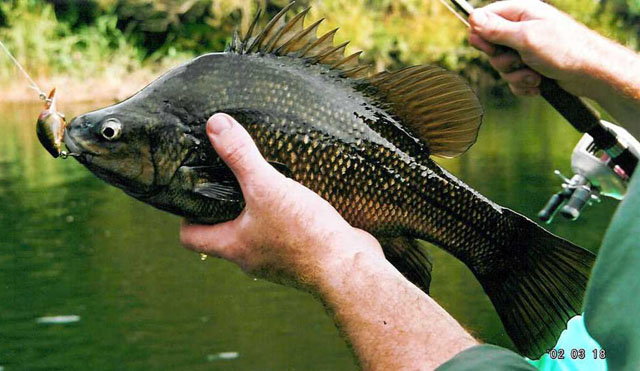| Percichthyidae (Temperate perches) |
| 46 cm SL (male/unsexed); max.weight: 3,500.0 g |
|
benthopelagic; freshwater; depth range 0 - 4 m, potamodromous |
| Oceania: Once widely distributed in the Murray-Darling basin and southeastern coastal drainages. Now reduced to cooler upper reaches of Murray-Darling basin, New South Wales, Australia. Introduced in the Wannon, Barwon, Yarra Rivers (Victoria) and the Nepean and Shoalhaven Rivers (New South Wales), Australia. |
|
Dorsal spines (total): 8-12; Dorsal soft rays (total): 12-15; Anal spines: 3-3; Anal soft rays: 8-11; Vertebrae: 28-31 |
| Occurs in lakes and flowing streams usually in deep holes with rock or gravel substrates (Ref. 5259). Inhabits cool, clear water of rivers, lakes and reservoirs. Prefers slow-flowing, deep rocky pools. Solitary, swimming near the bottom or in mid-water, but form small shoals during the spawning season (October to December) (Ref. 44894). Forms large shoals near shore. Fry feeds on zooplankton; adult on aquatic insects, crustaceans and mollusks. Male matures at 20 cm (2 y), female at 30 cm (3 y). Spawns upstream in spring or early summer; eggs hatch in 13-18 days; larvae of 7 cm TL (Ref. 5259). Moves into areas just upstream of shallow riffles over gravel or rocky bottoms to spawn. The female releases demersal eggs which sink into cracks in the substrate. Fish in reservoirs move into flowing feeder streams to spawn. Sexual maturity is reached after 2 years (20 centimeters) for males, 3 years (30 centimeters) for females (Ref. 44894). Tolerates temp. down to 9°C (Ref. 7276). Infected by nematodes and copepod Lernaea cyprinacea (Ref. 7315). |
|
Endangered (EN); Date assessed: 11 February 2019 (A2ce; B2ab(ii,iii,iv)) Ref. (130435)
|
| harmless |
Source and more info: www.fishbase.org. For personal, classroom, and other internal use only. Not for publication.
